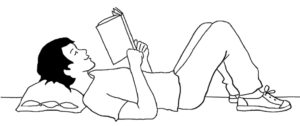Procedure:
The free reading sequence lasts 20–30 minutes; it can be complemented with a discussion where all students report about their readings, ask questions, or make recommendations.
Suggestions:
- Free reading sequences should take place regularly. This works well with heterogeneous HLT classes and sequences, during which the instructor works individually with different age groups.
- In free reading sequences, the students can mostly determine for themselves what they want to read. The may retreat somewhere for that purpose, but must do nothing else but read.
- In order to use the free reading time as productively as possible, students must learn how to make a reading plan, as well as how to keep a reading log. The reading log may be useful for later discussions about one’s own readings. Specific suggestions for both plans are found in teaching suggestions #11.
- These reading sequences must, however, be clearly structured for children and adolescents who are not used to concentrate for 20 minutes on a single task by themselves, or who have not yet acquired the ability to immerse themselves quietly in a book. Clear guidelines and instructions are necessary, at least in the beginning. This includes that noise and distractions are prohibited during these sequences, that students must plan their reading time beforehand, and that they are accountable for their work and must report after the sequence what and how much they have read.
- Alternatively, a good complement to free reaching sequences is reading in groups or as a class, as decribed in #11 below.







